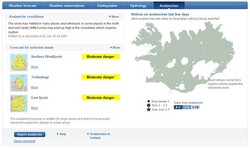Avalanche danger scale
Estimate of the risk of snow avalanches
On IMO's avalanche forecast maps, an international colour code is used, see below. The table and the icons are from EAWS.
A specific map is presented for each of three selected high risk areas. Additionally, IMO issues an avalanche bulletin on Mondays, Wednesdays and Fridays at 16:00 for these three selected areas in Icelandic. A comment on overall avalanche conditions in Iceland and a general weather forecast in terms of avalanche danger is given in English. It should be kept in mind that the avalanche forecast is written for large areas and does not necessarily represent avalanche danger in urban areas.
Danger scale
| Danger level | Icon | Snowpack stability |
Avalanche triggering probability |
|
|---|---|---|---|---|
| |
5 Very high |
 |
The snowpack is poorly bonded and largely unstable in general. | Numerous large-sized and often very large-sized natural avalanches can be expected, even in moderately steep terrain. |
| |
4 High |
 |
The snowpack is poorly bonded on most steep slopes. |
Triggering is likely even from low additional loads** on many steep slopes. In some cases, numerous medium-sized and often large-sized natural avalanches can be expected. |
| |
3 Considerable |
 |
The snowpack is moderately to poorly bonded on many steep slopes*. |
Triggering is possible, even from low additional loads** particularly on the indicated steep slopes*. In some cases medium-sized, in isolated cases large-sized natural avalanches are possible. |
| |
2 Moderate |
 |
The snowpack is only moderately well bonded on some steep slopes*, otherwise well bonded in general. |
Triggering is possible primarily from high additional loads**, particularly on the indicated steep slopes*. Large-sized natural avalanches are unlikely. |
| |
1 Low |
 |
The snowpack is well bonded and stable in general. |
Triggering is generally possible only from high additional loads** in isolated areas of very steep, extreme terrain. Only sluffs and small-sized natural avalanches are possible. |
* The avalanche-prone locations are described in greater detail in the avalanche bulletin that comes with the risk estimate (altitude, slope aspect, type of terrain).
- moderately steep terrain: slopes shallower than 30 degrees
- steep slope: slopes stepper than 30 degrees
- very steep, extreme terrain: adverse slope angle (more than 40 degrees), terrain profile, proximity to ridge, smoothness of underlying ground surface
** additional loads:
- low: individual skier / snowboarder, riding softly, not falling; snowshoer; group with good spacing (minimum 10m) keeping distances
- high: two or more skiers / snowboarders etc. without good spacing (or without intervals); snowmachine; explosives; single hiker/climber
The table and icons above are from EAWS
Selected areas
Maps are presented for three selected areas:
Northern Westfjords from southern Dýrafjörður north to Ísafjarðardjúp and to the mountains east of Álftafjörður.
Northern Tröllaskagi marked by the mountains west of Siglufjörður, towards east through Ólafsfjörður and into Dalvík, as well as the mountain range above this area.
Eastfjords marked by Seyðisfjörður in the north and Fáskrúðsfjörður in the south.
Additionally, an avalanche bulletin is issued in Icelandic every Monday and Thursday at 16:00 for each of these selected areas; and more frequently if needed.
A comment on overall avalanche conditions in Iceland and a general weather forecast in terms of avalanche danger is given in English.
The avalanche forecast is, however, written for large areas and does not necessarily represent avalanche danger in urban areas.
Notices on avalanches last few days
Adjacent to the avalanche forecast (level right) is a map of Iceland showing notices on avalanches which have fallen in the last few days. This function was introduced late last winter (early 2012).
It is important to understand that more avalanches are likely to have fallen without being reported; most notices come from regions where avalanche observers work.
On the main page is a button (below left) for reporting avalanches. Another link invites comments on avalanches.




